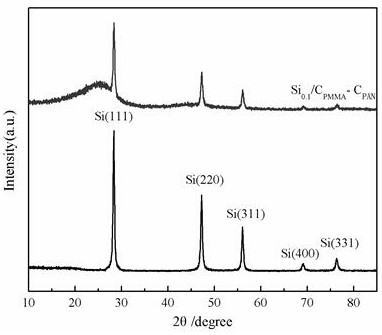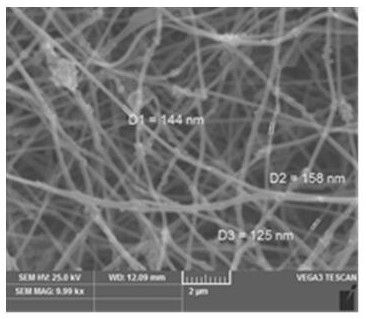A kind of preparation method of nano-silicon-carbon composite negative electrode material for lithium ion battery
A lithium-ion battery and negative electrode material technology, applied in battery electrodes, secondary batteries, circuits, etc., can solve the problems of nano-silicon particle material pulverization, long diffusion and migration path, and poor electrode conductivity, etc., and achieve small particle size , improve electrochemical activity, uniform particle size effect
- Summary
- Abstract
- Description
- Claims
- Application Information
AI Technical Summary
Problems solved by technology
Method used
Image
Examples
Embodiment 1
[0034] 1) Accurately weigh 2.8g of polyacrylonitrile (PAN) powder, 14.4g of N,N-dimethylformamide (DMF) in a 50ml small beaker, and place it in an oil bath at 50°C for 3h at constant temperature, After the PAN powder is completely dissolved, ultrasonically disperse for 4 hours to obtain an outer layer precursor emulsion with a concentration of 14%, which is ready for use;
[0035] 2) Accurately weigh 0.4g of nano silicon powder (30nm) and 0.03g of Y-aminopropyltriethoxysilane (KH550) and soak in a 50ml small beaker for 5min, then add 2.6g of polymethyl methacrylate (PMMA) After powder and 17.4g N,N-dimethylformamide (DMF), it was placed in a 35°C oil bath and stirred at a constant temperature for 3 hours. After the PMMA powder was completely dissolved, it was ultrasonicated for 2 hours to obtain a concentration of 13%. Inner layer precursor emulsion, ready for use;
[0036] 3) Select two 20ml syringes to absorb the inner layer emulsion and the outer layer emulsion respectivel...
Embodiment 2
[0041] 1) Accurately weigh 2.8g of polyacrylonitrile (PAN) powder, 14.4g of N,N-dimethylformamide (DMF) in a 50ml small beaker, and place it in an oil bath at 50°C for 3h at constant temperature, After the PAN powder is completely dissolved, ultrasonically disperse for 4 hours to obtain an outer layer precursor emulsion with a concentration of 14%, which is ready for use;
[0042] 2) Accurately weigh 0.4g of nano silicon powder (30nm) and 0.03g of Y-aminopropyltriethoxysilane (KH550) and soak in a 50ml small beaker for 5min, then add 2.8g of polyacrylonitrile (PAN) powder, After 14.4g of N,N-dimethylformamide (DMF), it was placed in a 50°C oil bath and stirred at a constant temperature for 3 hours. After the PAN powder was completely dissolved, it was sonicated for 2 hours to obtain an inner layer precursor with a concentration of 14%. Body emulsion, ready to use;
[0043] 3) Select two 20ml syringes to absorb the inner layer emulsion and the outer layer emulsion respectively...
Embodiment 3
[0048] 1) Accurately weigh 2.8g of polyvinylidene fluoride (PVDF) powder, 14.4g of N,N-dimethylformamide (DMF) in a 50ml small beaker, and place it in a 35°C oil bath and stir for 3h After the PVDF powder is completely dissolved, ultrasonically disperse for 4 hours to obtain an outer layer precursor emulsion with a concentration of 14%, which is ready for use;
[0049] 2) Accurately weigh 0.4g of nano silicon powder (30nm) and 0.03g of Y-aminopropyltriethoxysilane (KH550) and soak in a 50 ml small beaker for 5min, then add 2.6g of polymethyl methacrylate (PMMA) After the powder and 17.4g N,N-dimethylformamide (DMF), it was placed in a 35°C oil bath and stirred at a constant temperature for 3 hours. After the PMMA powder was completely dissolved, it was ultrasonically used for 2 hours to obtain a concentration of 12%. Inner layer precursor emulsion, ready for use;
[0050] 3) Select two 20ml syringes to absorb the inner layer emulsion and the outer layer emulsion respectively,...
PUM
| Property | Measurement | Unit |
|---|---|---|
| diameter | aaaaa | aaaaa |
| diameter | aaaaa | aaaaa |
Abstract
Description
Claims
Application Information
 Login to View More
Login to View More - R&D
- Intellectual Property
- Life Sciences
- Materials
- Tech Scout
- Unparalleled Data Quality
- Higher Quality Content
- 60% Fewer Hallucinations
Browse by: Latest US Patents, China's latest patents, Technical Efficacy Thesaurus, Application Domain, Technology Topic, Popular Technical Reports.
© 2025 PatSnap. All rights reserved.Legal|Privacy policy|Modern Slavery Act Transparency Statement|Sitemap|About US| Contact US: help@patsnap.com



